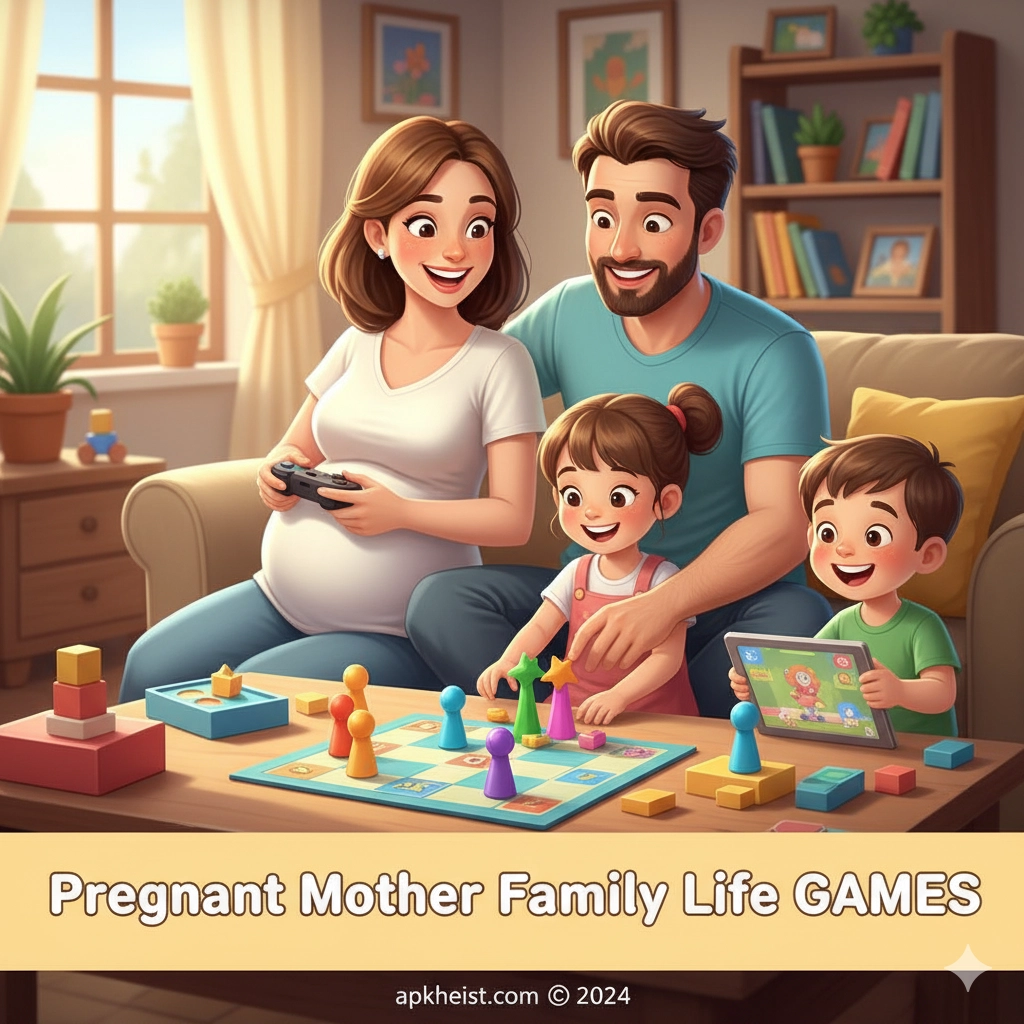In Pregnant Mother Family Life Game, you’ll manage routines, doctor visits, emotional well-being, and household dynamics while preparing for a new baby. The game blends light simulation mechanics with interactive storytelling: balance nutrition and rest, decorate the nursery, resolve family conflicts, and choose how to spend limited resources. Through branching scenes and mini-tasks — from a calming prenatal yoga session to a last-minute hospital dash — players experience the joys and stresses of preparing for parenthood. Along the way you’ll build relationships with partners, relatives, and friends, unlocking new dialogue and outcomes depending on your choices. This is a compassionate, family-focused title that emphasizes empathy, planning, and the small, meaningful moments that define family life. Simulation elements keep gameplay engaging, while light casual interactions make it accessible to players of all ages.
1. Prenatal Care & Routine — Small description: Track appointments, manage symptoms, and keep mood and health in balance. Includes a short mini-game where you follow a healthy daily schedule. Educational
2. Home & Nursery Design — Small description: Choose furniture, colors, and safety items for the nursery in a fun decorating mode that impacts baby comfort and parental stress.
3. Relationship & Support System — Small description: Navigate conversations, requests, and compromises with a partner, family, and friends; your support network affects outcomes. Role Playing
4. Work-Life Balance — Small description: Decide when to work, when to rest, and how to allocate finances. Make choices that affect career progress and family harmony.
5. Labor Preparation & Birth Plan — Small description: Create a birth plan, pack a hospital bag, and respond to unexpected events in a tense, story-driven scenario. Adventure
6. Baby Care Basics — Small description: Learn feeding, soothing, and diapering through guided tutorials and intuitive mini-games; success influences baby happiness meters. Puzzle
7. Long-Term Family Growth — Small description: See how early decisions echo into family routines, finances, and relationships months after the baby arrives; strategic choices reward stability. Strategy
1. Prenatal Care & Routine
In the Prenatal Care & Routine chapter you’ll manage day-to-day health and wellbeing with a focus on realistic, empathetic choices. Each day is represented by a set of time blocks where you decide whether to rest, attend a checkup, prepare a nutritious meal, exercise, or connect with a loved one. The game models common pregnancy symptoms — fatigue, nausea, mood swings — and gives players options for coping: short naps, hydration tasks, or calming breathing exercises. Appointments are scheduled in an in-game calendar; missing them increases risk factors and can change later story branches. The mini-game tied to this section uses simple timing mechanics to simulate preparing balanced meals or completing light prenatal exercises — success grants temporary stat boosts like reduced stress and better sleep. Emotional support is equally important: regular conversations with your partner or friends refill the “support meter,” enabling access to certain dialogue options and resources. This section is designed to teach basic prenatal health awareness while keeping gameplay compassionate and low-pressure.

2. Home & Nursery Design
Designing the nursery is both a creative outlet and a gameplay mechanic: choices you make about layout, storage, and safety have measurable effects on parental stress and baby comfort after birth. The design interface offers a catalog of furniture (cribs, changing tables, rockers), decor (paint colors, mobiles, wall art), and safety upgrades (outlet covers, cabinet locks). Each item has cost and space considerations; players must work within a budget and room dimensions. Some items unlock when you complete community tasks or build stronger relationships with supportive characters. The game includes accessibility options and safety checklists, prompting players to think about real-world infant care best practices. Visually, the nursery grows warmer as you add personal touches, and certain color schemes or tactile items trigger longer, cozy cutscenes where the expectant mother imagines future moments with the baby — a design that reinforces the emotional core of the game.
3. Relationship & Support System
Relationships form the emotional backbone of the game. This chapter explores how communication, trust, and shared responsibility affect outcomes. Dialogue trees let you choose tone, timing, and content of conversations with your partner, parents, or friends. Opting for honest, calm communication may resolve conflicts more quickly and open up shared parenting tasks, while avoidance or harsh words can increase stress and limit access to joint resources. Interactions are often accompanied by small tasks — like preparing a favorite meal for your partner or attending a counseling session — that, when completed, permanently improve relationship stats. NPCs have distinct personalities and reliable schedules; learning their rhythms lets you arrange support when you need it. The mechanics encourage empathy: sometimes the best move is to ask for help, and sometimes it’s to accept help offered. These choices subtly change available endings and influence post-birth scenarios.
4. Work-Life Balance
Work-Life Balance asks players to make practical decisions under pressure. Schedules, deadlines, and financial obligations are presented through a simple task queue: accept overtime, request flexible hours, or take unpaid leave. Each decision impacts household income, stress levels, and career trajectory. The game models consequences with clear feedback — missing a deadline might reduce a work performance stat but free up time for crucial prenatal appointments. Budgeting mini-tasks let you plan for large purchases (crib, stroller) without compromising essentials like groceries and medications. The aim is not to penalize players but to present realistic tradeoffs and promote thoughtful prioritization. Strategic planning here leads to smoother transitions after the baby arrives, demonstrating how small, sensible choices build long-term stability.
5. Labor Preparation & Birth Plan
As the due date approaches, tension and anticipation rise. This chapter guides players through creating a birth plan by selecting preferences: hospital vs. birthing center, pain management options, who will be present, and contingency choices. The game includes an emotionally authentic labor sequence with branching outcomes based on preparation and luck. Players must react to time-sensitive prompts — when to go to the hospital, which bag to pack, and how to support a partner in labor — that test prior planning. A calming mini-interaction helps manage panic (guided breathing with rhythm cues). Multiple endings reflect different birth scenarios, but the game emphasizes resilience: regardless of unexpected turns, supportive choices and preparedness yield stronger bonding scenes and positive epilogues. This section combines narrative intensity with clear, actionable choices to keep players engaged and emotionally invested.
6. Baby Care Basics
Once the baby arrives, practical care becomes central. The Baby Care Basics section teaches feeding schedules, soothing techniques, and diapering through hands-on mini-games and interactive tutorials. Tutorial prompts are optional and fully accessible — players can skip or replay them without penalty. Successful completion of tasks increases the baby’s comfort meter, reduces crying episodes, and improves parental confidence stats. You’ll learn to read sleep cues, manage burping, and perform safe swaddling. The game also models postpartum recovery: the mother’s health and mood are tracked and influenced by rest, nutrition, and support. This respectful approach highlights that learning parenthood is gradual and that mistakes are part of the process, offering players encouraging feedback rather than harsh punishment.
7. Long-Term Family Growth
The final chapter looks at the ripple effects of your choices. Months after birth, the household has routines, a budget, and social rhythms that reflect earlier decisions. Did you prioritize career continuity or extended parental leave? Did you invest in community relationships or focus on financial buffers? These choices shape school readiness, family traditions, and long-term wellbeing. The game offers epilogues showing different family states: a cozy, stable home; a busy but resilient household; or a family still learning to find its footing. Importantly, the game frames every ending with hope and growth — there are no “wrong” outcomes, only different paths. Replayability is encouraged by alternate scenarios, unlocked content, and achievements tied to compassionate parenting choices.
FAQs:
Q1: What age rating is appropriate for Pregnant Mother Family Life Game?
A1: The game is designed for teens and adults due to themes around pregnancy and childbirth, recommended for ages 13+ with parental guidance for younger players. Content focuses on emotional and practical aspects rather than graphic medical detail.
Q2: How long does a typical playthrough take?
A2: A single full playthrough (from early pregnancy through the post-birth epilogue) typically runs 4–8 hours, depending on how many side activities and mini-games you complete.
Q3: Are the medical recommendations in the game realistic?
A3: The game offers general, educational suggestions (e.g., attend prenatal appointments, rest, nutrition). It is not a substitute for professional medical advice; players are reminded to consult real healthcare providers for specific concerns.
Q4: Can I customize the character’s partner and family background?
A4: Yes — early in the game you can customize the partner’s personality, occupation, and some family backstory elements. These choices influence dialogue trees and available support options.
Q5: Does the game include multiple endings?
A5: Yes. There are several endings that reflect different family outcomes based on your decisions about care, relationships, finances, and preparation. The endings prioritize growth and learning over “success/failure” dichotomies.
Q6: Is there a mode for parents who want a gentler experience?
A6: The game includes a Relaxed Mode that reduces time pressure, simplifies mini-games, and increases caregiver support availability for a low-stress experience.
Q7: Can I play mini-games like nursery design or feeding tutorials separately?
A7: Yes — most mini-games are available in a Practice Hub where you can design rooms, rehearse feeding techniques, and replay calming exercises without affecting main story progression.
Adventure Action Role Playing Arcade Casual Strategy Sports Simulation Racing Puzzle Card Music Board Educational Trivia Word






